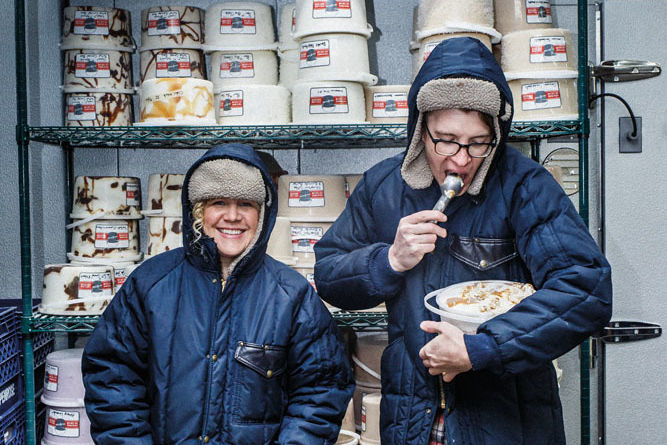
How Salt & Straw Captured Portland in a Cone
In March 2011, a shy, pompadoured 23-year-old named Tyler Malek—lately released from a car salesman’s job for “being too nice”—experienced an epiphany while roasting bone marrow in his kitchen in Snohomish, Washington. Marrow owes its rich, meaty wallop mostly to its fat content; fat is the ultimate flavor delivery vehicle. Ice cream is mostly fat; fats are interchangeable.
Bone marrow ice cream. It was possible. Not just possible: to Tyler Malek, it was suddenly obvious.
Malek was soon begging his older cousin, Kim, to give him a shot at the high-craft ice cream shop she planned to open in Portland that summer. Instead of an interview, Tyler sent a list of 60 flavor ideas: “chicken liver and maple syrup, spruce tips with (what??), madrone bark with crisp apples, smoked berry jam, licorice fern, bone marrow and bourbon cherries.”
Kim Malek, at age 40, was chasing her entrepreneurial dream after building a deep résumé as a marketing sharpshooter for Fortune 500 companies. (At one point, she held the enviable title of Starbucks’ “Director of Frappuccino.”) She was, at first, leery of her cousin’s wild-child vision for her company. “I’m just not sure I’m ready for bone marrow ice cream,” she told him.
“Get over it,” Tyler shot back.
Three years later, the Maleks’ ice cream company, Salt & Straw, runs three locations across Portland, each typically besieged by a huge line. Sunshine, sideways rain, snowstorm—doesn’t matter. On a recent day at the original shop at NE Alberta and 20th, a neatly dressed couple ordered the Melon and Prosciutto, for breakfast. (The meat came from Olympic Provisions, one of Salt & Straw’s many local collaborators.) Before noon customers started lining up: first, a trio of girls who stared excitedly at the flavor board, giggling like teenagers at a One Direction concert. By nightfall, the tiny shop had Jay Z tracks pumping and 100-strong milling outside, all waiting for an experience.
Salt & Straw has become as essential to Portland iconography as a trip to Powell’s Books or wings at Pok Pok. People used to come here to hike or ski. Now, visitors arrive and say, “Take me to Salt & Straw!” Can ice cream be that good? At Salt & Straw’s best, its flavors are off the charts; the worst evoke your first breakfast-in-bed for mom. But in fascinating ways, the company transcends its humble frozen medium. With no food experience, the Maleks set out to create an ice cream store informed by a charitable bent and a “farm-to-cone” cry straight from the foodie cliché handbook. In an act of accidental brilliance, they unleashed something more: a new kind of ice cream entirely, with collaboration at the heart of its formula, bundling all the happiness of Portland in a fresh-made cone with a vanilla perfume that grabs you a block away.
These days, their menu reads like a cheat sheet to Portland’s food world: Salt & Straw pulls in local chefs, bartenders, bakers, brewers, coffee roasters, and chocolatiers to guest-star in ever-changing collaborative creations. What grows here, literally and spiritually, churns through these flavors: the entrepreneurial spirit, love of brazen flavors, pet charities, an almost parody-level local pride. (“Fresh-picked dandelions” featured recently. Is there another kind?) Even black truffles get into the act, scrounged from beneath the earth to lend a taste of Oregon’s spooky woods, frozen in cream.
Salt & Straw has transplanted the semimystical idea of terroir—that every place has a unique flavor that springs from its soil and environment, typically expressed through wine—into an ice cream cone.
The story can be told in five flavors.
1. SEA SALT WITH CARAMEL RIBBONS
The salt hits you first, pervasive as a heartbeat. Then you notice the base: snow white and fluffy, luxuriating in fresh cream. A primordial ooze of caramel slashes through every other bite. This is Sea Salt with Caramel Ribbons, Salt & Straw’s crowning achievement, one of 10 house “classics” that join five monthly specials from Tyler Malek’s freewheeling mind at each location. Early on, everyone was talking about the Strawberry Honey Balsamic with Black Pepper, dizzy in love or seriously hating it; these days, Sea Salt with Caramel Ribbons is the ruling cult classic. Mark Bitterman provided the necessary course correction.
Bitterman, who sells and expounds upon gourmet salts at his two locations of the Meadow, says he felt a connection with the cone peddlers right away. “They were passing off these weird-ass ideas, like pears and cheese,” recalls Bitterman. “Yet there was no showing off, no ostentation. It made them charming and attractive.”
He did, however, want to tell the Maleks something. A few weeks after the Alberta location opened in 2011, Bitterman arrived at the counter, toting a briefcase like a KGB agent, demanding to talk to Tyler. The situation? The meek early version of the salted caramel contained kosher salt, which Bitterman considered a palate dullard. Bitterman pulled out dozens of salt varieties, talking about taste, technique, impact, linger. Hours later, they settled on a Guatemalan fleur de sel—“the killer app of salt,” as Bitterman calls it—with beautiful crystalline complexity and full flavor.
“Just from that meeting,” says Tyler, “I understood what salt can do.”
More connections with Portland’s burgeoning artisan-foods community followed. Tyler learned the deceptively complicated dark arts of caramel, for example, from chocolatier David Briggs, whose award-winning Raleigh Bar releases enough smoky caramel to set off alarms. Briggs’s formula would be a trade secret in other, meaner, more cutthroat cities. In Portland, it was an idea to share. “David taught me the science,” Tyler says, “techniques you can’t learn in books about large-scale production.” Now, handmade caramel in every form—pork-bellied, turkey-skinned, fish-sauced, beer-stouted—snakes through Salt & Straw’s flavor world.
A few months later, the Maleks met chocolatier Charlie Wheelock, who was pushing his raw material to its ultimate expression in his Southeast basement, two kilos at a time, individually numbering each of his new Woodblock Chocolates. Wheelock sourced, cracked, ground, roasted, and conched cacao beans with antique machines and sweat. His example inspired Malek to collaborate, as he puts it, “with purpose.” Now Salt & Straw’s menu celebrates not only single artisans or unexpected flavors, but also incidentally documents local food movements and the ideas, obsessions, and talents driving them. For anyone who paid attention, a suite of scoops posted on Salt & Straw’s board in February 2012 decoded Portland’s fascinating chocolate scene. There was Sahagún’s brainy Oregon Kiss; Briggs’s wild Sourdough Olive Oil Ganache; and Wheelock’s purist Freckled Woodblock Chocolate, touched by only cream and Jacobsen salt.
The model has expanded to include flavor series chronicling Portland’s tea makers, craft brewers, and innovative bartenders. Tyler Malek’s mathematics of creation had changed. As he puts it, “one and one equals three.”

Image: Stuart Mullenberg
2. FOIE GRAS S’MORES WITH VEAL STOCK FUDGE AND HAZELNUT GRAHAM
Getting inside the heads of Portland’s chefs seemed the logical next step. Things were bound to get weird.
Salt & Straw’s introduction to Portland’s culinary world came in 2011 at Wild About Game, an annual cooking competition that pits local and visiting chefs in a contest of wit and animal savvy. Chef Greg Denton, at the time with Metrovino but soon to launch Ox, took top honors. His s’mores-inspired duck dish juggled giblet sausage, toasted foie gras marshmallow fluff, cocoa sauce, graham cracker crumble, and, for the crowning touch, campfire smoke trapped under a glass bowl. Tyler Malek was on hand, scooping bone marrow ice cream. Denton reached the obvious conclusion: “Dude, we totally have to make this into ice cream.”
But freezing is totally different from cooking. It took three months of back-and-forth sampling, five runs at veal stock fudge, and a eureka moment of tapping smoked vanilla to stand in for campfire fumes to channel Denton’s baroque vision into scoop form. The experiment, a hit with thrill-
seekers, taught Malek his preferred way of working with chefs: he operates like a culinary version of the music-studio svengali Danger Mouse, both a collaborator and producer.
In 2012, Malek captured Troy McClarty’s Bollywood Theater (next door to the Alberta S&S) and its crush on Indian street food in a cone of cardamom ice cream, carrot custard, and pistachio buttercream. A year later, he sussed out what was on the mind of Le Pigeon’s Gabriel Rucker, the visionary two-time James Beard champ: toasted hearts of palm and peanut butter and jelly. “He’s one of the most talented people putting flavors and compositions together,” Rucker says.
Salt & Straw’s monthly specials offer a snapshot of a time and place. Years from now, digging through fossilized pints of Brown Ale and Bacon alongside Mint-Scented Sea Urchin Meringue, an archaeologist could grasp the evolution of Portland’s chef scene. “I go back a year later and their voices have changed,” says Tyler. He’s catching a flame, a moment of creativity—and freezing it.
3. BUNK HAWAIIAN
“I don’t want to look at your menu,” Tyler Malek tells Tommy Habetz. “The idea isn’t to copy a dish or dessert. I want to capture your spirit, tap into that amazingness for a second.”
Habetz, impresario of the bombastic Bunk Sandwiches mini-empire, sits on one side of a booth wearing a T-shirt bearing the shouting visage of ex-Blazer Rasheed Wallace and the words “Bunk Don’t Lie.” Malek, a 6-foot-2 embodiment of low-key chill, sits on the other side and removes his baseball cap, allowing his perpetually unmade pompadour to erupt in sandy, scattershot strands around his boyish face. They begin riffing on a future flavor.
Habetz’s opening lob is “fried rice—make that coconut fried rice with pineapple and pork belly.”
“Oooh! I love the idea,” Tyler shoots back. (You sense he always says that.) The conversation progresses to talk of dark caramelized pork belly and pineapple jam. And then, Tyler offers, how about an elevated Rice Krispies for the fried rice element? “I’m not sure what that means,” Tyler confesses, “but I like the idea, texturally, of breaking up the power of the pork belly and ice cream.”
Every Salt & Straw collaboration begins with a brainstorming session, then a sketch. Tyler carries a notebook filled with intricately scribbled notes and diagrams that rope in personalities, philosophies, quirks. (His page for Habetz includes the phrase “Big Flavors.”) After several trial runs, Tyler and Habetz settle on toasted coconut ice cream beaming rays of candied pineapple, toasted Rice Krispies, and Bunk pork belly jelly: bright, salty, sweet, with a little pig and funk.
“What shall we call it?” asks Tyler. Hawaiian Pizza Jam takes the lead, then Stoner Pizza Jam. And then, a brainstorm: “We need to put this on bread,” says Habetz. The pair decide to tuck the scoops between slices of toasted island sweet bread.
Bunk Hawaiian is born, and scheduled for August release. After which, it should be said, the recipe will disappear into Malek’s archives, maybe never to return. For all the effort, the life span of this creation, like most Salt & Straw specials, is a mere four weeks. Ideas must die so new ones can live. However popular his specials, Tyler doesn’t get attached. The process evokes Buddhist sand mandalas: intricately made then ritually destroyed.
4. OLDE PEOPLE
“Hello, my name is Tyler Malek. I make ice cream. That is a real job. And I need your help.” With that salvo last spring, 1,500 kids from Chapman, Vernon, and Abernethy schools embarked on a Salt & Straw challenge: imagine a flavor, share your “secret ingredient,” and maybe earn money for your school. Salt & Straw would turn the best ideas into flavors and invite customers to vote on three winners from nine finalists, with 15 percent of the proceeds going to each school’s PTA. It’s altruism, plus advertising Don Draper couldn’t top: every student, parent, cousin, and Facebook friend, of course, showed up at Salt & Straw to weigh in.
The contest submissions show many little Tyler Maleks at work: flavors like “Gummy Worm Pasta” and “Bad Morning Refresher,” the latter made with doughnut crumbs, coffee, and cream. What strikes Tyler is the lack of barriers. “When you’re a kid,” he says, “if you can imagine it, you can do it.” This could be Salt & Straw’s own motto. You realize that Tyler never outgrew his childlike urge to create universes. Ice cream is his Dungeons & Dragons.
The charmingly misspelled “Olde People” speaks most directly him. The entry calls for “ice tea, lemonade, crushed Werther’s [hard caramels], a sprinkle of wheat germ, and a hint ’o mint (Ben Gay).” “It was completely unrestrained, without any boundaries of what is ‘realistic’ in food,” he recalls. “I had to make it.” He worked just as hard translating these fleeting kids’ flavors as he did on any collaboration with a name-brand chef. It took four iterations just to solve Olde People’s wheat germ challenge—Tyler embraced it to chewy effect in a Florentine cookie chunked into a sea of melted Werther’s, cream, and sweet lemon iced tea.
It would be easy to dismiss Salt & Straw’s contests and collaborations as a marketing strategy writ large. But watching the Maleks in action, the sense is of people just doing what they love, the idea of being a kid forever while building community. It just happens to coincide with Kim’s feel for business and Tyler’s fevered creativity. “It’s a fascinating style,” says Bitterman. “They’ve built their brand in part by incorporating pieces of many other brands. It’s intensely strategic, but not cynical. In a crowded friendly room, Kim is talking to everyone. They have a remarkable receptivity. They want to help everyone around them. They’re taking everyone with them.”
5. LOADED BAKED POTATO
The Maleks started with a shared 30-foot freezer and five employees. Three summers later, Salt & Straw encompasses 100-plus employees and three brick and mortar shops. Its custom-made carts go wherever the action is, be it a Pink Martini holiday party or the Moda Center’s food court on Blazer nights. In its new east-side R&D lab, hair-netted elves bake, swirl, and hand-pack pints—a strange Candy Land with its own 1,000-square-foot arctic food vault.
The Maleks cracked Portland’s food code. Now comes their biggest conceptual leap: the cousins are taking the model to Los Angeles, building the idea from scratch again, exporting a philosophy, not flavors. Only a few sacred “classics,” like Woodblock Chocolate and Sea Salt with Caramel Ribbons, will make the journey south to a new location in LA’s Larchmont Village neighborhood, set to open this month. Everything else will begin anew.
“This is our fuck-you to McDonald’s,” says Tyler. “You can be local everywhere. It’s possible to create something unique for a community.”
Will a deep engagement with LA chefs, artisans, and farmers matter—or will success hinge on whether Brad and Angie show up? The Maleks have already made inroads, at least with hard-core foodies. Since last year, food emporium Joan’s on Third has been scooping Salt & Straw’s signature flavors on Melrose Avenue and drawing comments like “holy shit that’s good” on LAist, the popular food blog. And big-name chefs seem game to collaborate, Portland-style. For last fall’s Feast Portland food festival, Malek cold-called Michael Voltaggio, a swaggering Top Chef winner and chef of hot spot Ink restaurant, with an offer to capture his culinary muses in an ice cream cone. After months of Fed-Exed trial runs, their Loaded Baked Potato, with chocolate-cloaked bacon crumbs and white-cheddar cookie dough, suggested what an ice cream might look like from the spiritual home of In-N-Out Burger.
Finding ingredients will be easy. The hard part will be doing there what Salt & Straw has done here: locating a taste of something undeniably singular, the terroir of Los Angeles. Avocado and Goat Cheese? A pint called Narcissism? Or perhaps it’ll be the next step in Asian food: a scoop of boiled peanuts, black vinegar, ginger, Thai chiles, and cilantro-fish sauce. (Tyler just made that combo with his newest recruit, Roy Choi, food-truck legend and Korean taco pioneer.) Right now, the Maleks have no idea. They’re just open to meeting a whole new food community. Who knows what it might taste like?




